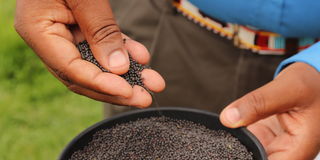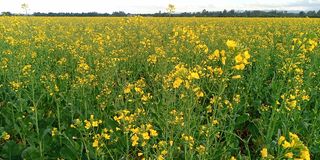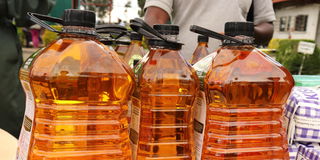Rongai maize farmer opts for canola after years of disappointment

A farmer inspects some of the canola seeds that were harvested at a farm in Kabarak.
Canola is a beautiful small yellow-flowered crop that grows about three to five feet tall, whose pods from which seeds are harvested are crushed to create canola oil and animal feed.
The oil seed, which ranks high amongst healthier edible and vegetable oils for its low saturated fat content, is gaining popularity among many households.
Additionally, the multipurpose cash crop is used to enhance soil health and as a crop rotation alternative.

A plantation of Canola in Kabarak area.
For farmers like Richard Bett, who for a long time had been suffering poor yields and low prices for his maize crop, the oilseed offered a Hail Mary.
Before 2021, he notes that he decided to leave his 5-acre piece of land land idle and graze his livestock there because even the price of a bag of maize wouldn’t surpass Sh. 2500.
“I had been doing cereals and was barely breaking even due to poor yields. I was unmotivated and decided to only put an acre under production- for consumption- while the rest remained idle for my animals to graze.”
Once when having a conversation with a friend who mentioned going to harvest canola, he wondered what that was and if it would give him a break from the loss he’d previously incurred. He then decided to seek the company that helped farmers set up.
Now, the canola farmer in Rongai sub-county is elated about how the crop has helped him improve his farm’s output.
His first time doing canola was a leap of faith that has now seen him use the rotational crop to increase his yield per acre by about 60 percent.
“I was hardly getting 15 bags per acre. After I did canola and then the following year planted maize, I had an impressive improvement in yield. I have since been motivated to increase my acreage as I now harvest about 25 bags per acre, which is modest.”

A farmer displays bottles of Canola oil ready for sale at a farm in Kabarak.
He tells Mtaa Wangu how his neighbours have marvelled at which variety he’s been planting, yet it has been the same due to the high yield he has been able to harvest. He is hopeful that his farm’s productivity will improve to about 30-35 bags as he eases into expansion.
After processing, among the by-products the canola crop produces is the canola cake meal used as feed for livestock, known to increase milk production due to its high protein content.


